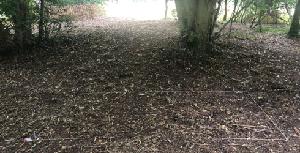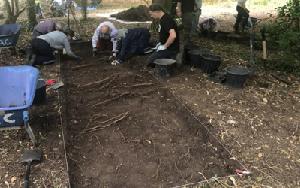09 Jul 2023
2023 Summer Dig - Day 1

Today we returned to Forty Hall to resume our ongoing hunt for the inner gatehouse of Elsyng Tudor palace.
See the 2022 dig and the 2021 dig for the previous work leading up to this year's dig.
For the last few years we have been investigating an area on the western side of the palace's outer courtyard, which we know from previous years' research occupied roughly the area at the end of the present-day lime tree avenue. We also know, from work done in the 1960s, that the inner courtyard was located in what is now increasingly dense woodland on the western side of the avenue, but what is not currently clear is where the two courtyards were connected.

We know from documentary research that there was a large multi-story gatehouse between the two, and that it was located close to a 'long barn', but despite having in recent years located what we believe to be that very barn, the adjacent gatehouse has so far proved harder to pin down.
Last year we did find evidence of a very substantial rubble-filled cut, which we think may be the remnant of the moat which ran in front of the gatehouse, and this year's Trench 1 was opened this morning slightly further west of last year's dig, to try and find the far side of the cut, which may lead us closer to the gatehouse itself.

As we have moved further west of the lime tree avenue we have begun to encounter some interesting topographical features, and the location of Trench one has brought us alongside a long-unexplained rectangular plateau hidden in the woods. The platform is clearly man-made and must be a palace feature, and so one possible interpretation is that it is the location of our missing gatehouse. Therefore we also opened trench two this morning on top of this platform, in order to find out more about it.
Although most of the morning was spent setting up the site and laying the trenches out, we were able to make a good start on both trenches and quickly removed the topsoil to reveal the expected demolition rubble layer created circa 1656 when the palace was finally demolished. We have now begun to remove the rubble in both trenches, and this is where we will pick up tomorrow morning, hopefully to reveal some new archaeology beneath it!